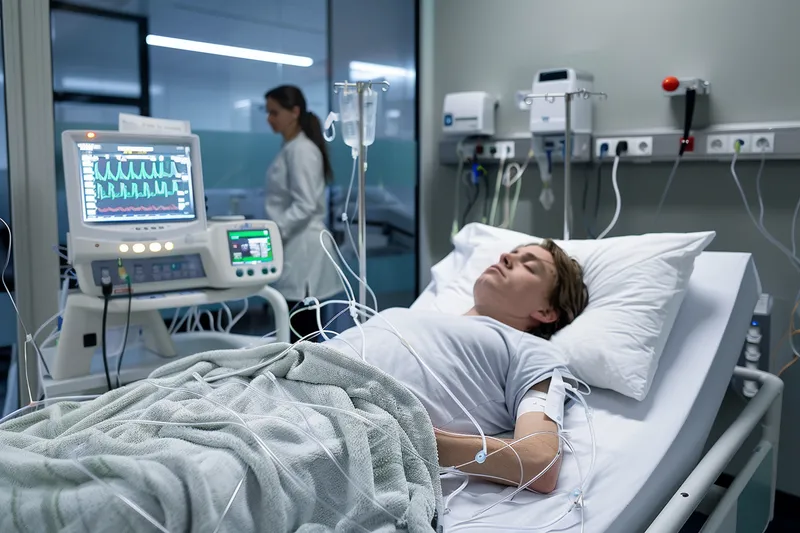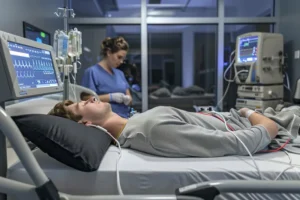Exploring the various methods for diagnosing sleep apnea in the UK is crucial for anyone experiencing symptoms of this sleep disorder. Sleep apnea tests in the UK range from home-based kits to in-lab sleep studies. These tests help individuals and healthcare providers understand the severity of the condition and decide on the appropriate treatment path. Understanding your options for sleep apnea testing can help you take the first step toward a better night’s rest and improved overall health.
Types of Sleep Apnea Tests Available in the UK
Sleep apnea is a significant medical condition that requires accurate diagnosis for effective treatment. In the UK, various types of tests are available to identify this disorder. These tests range from home-based assessments to in-lab studies and portable monitoring devices. Understanding the options can help individuals choose the most suitable method for their situation.
While the primary goal of all sleep apnea tests is to monitor and evaluate breathing patterns, oxygen levels, and other critical variables during sleep, the approach and tools used can differ significantly. This section explores the different types of sleep apnea tests available in the UK, providing insights into their methodologies and benefits.
Given the variety of tests available, it is crucial to consult healthcare professionals to determine the most appropriate type for accurate diagnosis and subsequent treatment. Below, we delve into the three main categories of sleep apnea tests: home sleep apnea tests, in-lab sleep apnea studies, and portable monitoring devices.
Home Sleep Apnea Tests
Home Sleep Apnea Tests (HSAT) have become increasingly popular due to their convenience and accessibility. These tests allow individuals to undergo sleep apnea assessments in the comfort of their own home. HSAT devices typically monitor variables such as airflow, heart rate, and blood oxygen levels throughout the night.
One of the key advantages of home sleep apnea tests is that they can be conducted in a familiar environment, potentially leading to more accurate results. Moreover, the cost of HSATs is generally lower compared to in-lab studies. This affordability makes it a viable option for many patients who might otherwise avoid testing due to financial constraints.
Despite their benefits, HSATs may not be suitable for everyone. For instance, individuals with severe medical conditions or those needing comprehensive sleep assessments might require more extensive testing. Healthcare providers often use HSATs as a preliminary diagnostic tool before recommending further in-lab evaluations if necessary. 
In-Lab Sleep Apnea Tests
In-lab sleep apnea tests, also known as polysomnography, are considered the gold standard for diagnosing sleep apnea. Conducted in a sleep laboratory or hospital setting, these tests offer a comprehensive evaluation of sleep quality and respiratory function. They monitor a broad range of parameters, including brain waves, eye movements, muscle activity, heart rhythm, and respiratory effort.
The structured environment of a sleep lab allows for detailed observation and analysis that can detect subtle abnormalities and complex sleep disorders. This level of scrutiny is particularly beneficial for patients with high-risk factors or those who exhibit severe symptoms of sleep apnea.
However, in-lab tests can be more costly and time-consuming than home-based alternatives. Patients are typically required to stay overnight at the facility, which might be inconvenient for some. Despite these drawbacks, the depth of data retrieved from in-lab tests often justifies their use, especially when a definitive diagnosis is crucial for effective treatment planning.
Portable Monitoring Devices
Portable monitoring devices are another option for diagnosing sleep apnea, offering a middle ground between home sleep tests and in-lab studies. These lightweight and compact devices can be used in various settings, providing flexibility for both patients and healthcare providers.
These devices typically track fewer variables than full in-lab studies, focusing primarily on key indicators such as oxygen saturation, heart rate, and respiratory effort. Portable monitoring is particularly useful for follow-up assessments and for patients who have already been diagnosed with sleep apnea and require ongoing monitoring.
Moreover, portable monitors can be used in specialized sleep clinics or at home, allowing for versatility in testing environments. This flexibility can lead to more consistent use and improved patient compliance, ultimately leading to better management of sleep apnea.
Although portable monitoring devices offer many advantages, they may not be as comprehensive as in-lab studies. Therefore, they are often recommended for patients with mild to moderate symptoms or those needing continuous monitoring rather than initial diagnosis.
Understanding the types of sleep apnea tests available can help in making informed decisions and ensuring effective diagnosis and treatment. Be sure to explore our other articles to gain a deeper insight into sleep disorders and their management.
How to Prepare for a Sleep Apnea Test
Sleep apnea is a serious condition that can significantly impact your overall health. If you have been scheduled for a sleep apnea test, it is essential to prepare adequately to ensure accurate results. In this guide, we will cover the steps you should take before your test to optimize your experience and get the most precise diagnosis possible.
From consulting with your healthcare provider to taking specific actions the night before the test, each step is crucial. Proper preparation can help in identifying the severity of sleep apnea and determining the most effective treatment plan. Below are key areas to focus on as part of your preparation.
Pre-Test Consultation
The first step in preparing for a sleep apnea test is to have a pre-test consultation with your healthcare provider. This session is essential for understanding what to expect during the test and discussing any medical history that may be relevant. Detailed communication with your doctor can help tailor the test to your specific needs.
During the consultation, ensure you:
- Discuss your symptoms and any other health issues you have.
- Review your current medications and determine if any should be paused before the test.
- Ask about any special instructions related to diet, sleep schedule, and lifestyle changes.
This information will help your doctor provide you with specific guidelines to ensure the test goes smoothly and yields accurate results.
Your healthcare provider might also recommend a trial run of the equipment at home if you are undergoing a home sleep test. Understanding how to use the equipment properly will minimize anxiety and increase the likelihood of obtaining quality data.
Night Before the Test
Preparation on the night before your sleep apnea test is equally crucial. Your actions and habits during this time can have a significant impact on the test results. Here are some steps to follow:
- Avoid caffeine and alcohol: Both substances can interfere with your sleep patterns and skew the test results.
- Stick to your regular sleep schedule: Try to go to bed and wake up at your usual times to ensure the test is as accurate as possible.
- Follow any specific instructions given by your provider: These may include dietary restrictions or guidance on physical activity.
Your goal is to create a typical sleep environment so the data collected reflects your true sleep patterns.
Moreover, it’s advisable to prepare your sleeping area in advance if you are doing a home test. Ensure your bedroom is quiet, dark, and comfortable. Setting up any required equipment beforehand can also alleviate stress and help you fall asleep more easily.
By following these preparation guidelines, you can contribute to a more accurate diagnosis, which is essential for effective treatment. These steps are relatively simple but can make a significant difference in the quality of your sleep apnea test results.
For more in-depth articles on managing sleep apnea and other related health topics, don’t forget to explore our other posts. Your journey to better sleep and health continues here!
What to Expect During a Sleep Apnea Test
Sleep apnea is a serious condition that affects many individuals worldwide. Diagnosing sleep apnea often requires a detailed analysis of your sleep patterns, which is typically completed through a sleep apnea test, also known as a polysomnography. Understanding what to expect during this test can help ease any concerns and ensure that you are well-prepared.
During a sleep apnea test, various physiological parameters are monitored to gather comprehensive data on your sleep. This test is usually conducted in a sleep clinic, although at-home testing options are also available. The test aims to identify interruptions in your breathing patterns and other anomalies that could indicate sleep apnea.
Setting Up the Equipment
The initial phase of a sleep apnea test involves setting up the equipment. You will be guided to a comfortable room, which is typically designed to mimic a home-like environment to make you feel at ease. A sleep technician will explain the process and answer any questions you might have.
Various sensors will be attached to your body to monitor different physiological signals. These sensors are generally placed on your scalp, face, chest, and legs. They are connected to a computer system that will record the collected data throughout the night. Although the sensors may feel slightly uncomfortable initially, they are designed to be as non-intrusive as possible. The technician will also set up a nasal cannula or a similar device to monitor airflow and occasional snoring. Additionally, video and audio equipment may be used to record movements and sounds that can provide further insights into your sleep patterns.
Monitoring and Data Collection
Once the equipment is set up, you will be encouraged to relax and go to sleep. Throughout the night, various parameters will be monitored, including brain waves, heart rate, oxygen levels in the blood, breathing patterns, and eye and leg movements.
These metrics help in identifying not just interruptions in breathing, but also the different stages of sleep you go through. Data collected on brain waves will show whether you are in light sleep, deep sleep, or REM sleep, while heart rate and breathing patterns will indicate any disturbances or irregularities.
It is important to maintain a typical sleep schedule during the night of the test to ensure accurate results. If you experience any discomfort or need assistance, you can alert the technician, who will be monitoring you from a separate room.
Post-Test Procedure
After you wake up, the technician will carefully remove the sensors and other monitoring equipment. You may feel some minor skin irritation where the sensors were attached, but this usually subsides quickly. It is crucial to follow any specific instructions provided by the technician regarding the removal of sensors and subsequent care.
The data collected during the test will be analyzed by a sleep specialist, who will look for signs of breathing irregularities, changes in oxygen levels, and other anomalies. This analysis helps in diagnosing sleep apnea and determining its severity, which is essential for developing an effective treatment plan.
Typically, a follow-up appointment will be scheduled to discuss the results of the test. During this appointment, the sleep specialist will review the findings with you and explain any recommendations for treatment, which may include lifestyle changes, the use of continuous positive airway pressure (CPAP) machines, or other interventions. Understanding what to expect during a sleep apnea test can help alleviate anxiety and ensure that you are properly prepared. For more information on sleep disorders and their treatments, be sure to check out our other articles.
Interpreting Your Sleep Apnea Test Results
Receiving the results of a sleep apnea test can be a bit overwhelming. Understanding the data can help you take the necessary steps toward better sleep and improved health. This guide will help you interpret your sleep apnea test results by breaking down the key components, such as the Apnea-Hypopnea Index (AHI), the severity of your condition, and potential treatment options.
Sleep apnea is a serious condition that can affect your overall health and well-being. Therefore, understanding your test results is crucial. These results provide valuable insight into the frequency of your apnea events, their severity, and how they impact your sleep quality.
By understanding your sleep apnea test results, you can work with your healthcare provider to develop a comprehensive treatment plan. Whether it’s lifestyle changes, medical devices, or possibly surgery, knowing the severity and specifics of your condition will guide you to the most effective solutions.
Understanding Apnea-Hypopnea Index (AHI)
The Apnea-Hypopnea Index (AHI) is one of the most critical metrics in diagnosing sleep apnea. The AHI measures the number of apneas (complete pauses in breathing) and hypopneas (partial pauses in breathing) you experience per hour of sleep. It’s a straightforward way to quantify the severity of your sleep apnea.
A lower AHI indicates fewer breathing interruptions and typically correlates with milder sleep apnea. Conversely, a higher AHI suggests more frequent interruptions, indicating more severe sleep apnea. The AHI is categorized as follows:
- Mild sleep apnea: AHI of 5-15
- Moderate sleep apnea: AHI of 15-30
- Severe sleep apnea: AHI of 30 or more
Understanding your AHI can help you and your healthcare provider determine the most appropriate treatment approach. It’s also useful to track your AHI over time to see if your condition is improving or worsening with treatment.
Severity of Sleep Apnea
The severity of sleep apnea is generally classified based on your AHI score. However, other factors such as the type of sleep apnea (obstructive, central, or complex) and the presence of other medical conditions can also play a role in determining severity.
Mild sleep apnea typically involves 5-15 events per hour and may cause subtle symptoms like light snoring or mild daytime fatigue. Moderate sleep apnea, with 15-30 events per hour, often leads to more noticeable symptoms, including louder snoring and increased daytime sleepiness.
Severe sleep apnea involves more than 30 events per hour and can lead to significant health issues. These may include cardiovascular problems, cognitive impairment, and a higher risk of accidents due to extreme fatigue.
Understanding the severity of your sleep apnea will guide the urgency and type of treatment needed. For instance, severe cases may require more aggressive treatments compared to mild or moderate ones.
Next Steps and Treatment Options
Once your sleep apnea test results are interpreted, the next step is to discuss treatment options with your healthcare provider. The treatment plan will depend on the severity and type of sleep apnea you have, as well as any other underlying health conditions.
Lifestyle changes are often the first line of treatment for mild sleep apnea. These may include weight loss, avoiding alcohol and sedatives, and sleeping on your side. For more severe cases, medical interventions may be necessary.
Common treatments include:
- Continuous Positive Airway Pressure (CPAP): This device delivers a constant stream of air through a mask, keeping your airway open while you sleep.
- Oral appliances: These devices reposition the jaw to maintain an open airway.
- Surgery: In some cases, surgical procedures may be required to remove obstructions or correct structural issues in the airway.
Choosing the right treatment is essential for managing sleep apnea effectively. Regular follow-ups and adjustments may be necessary to ensure the chosen treatment continues to work well for you.
Understanding and interpreting your sleep apnea test results is the first step toward better sleep and improved overall health. For more in-depth information on sleep apnea and its treatments, be sure to check out our other articles.
FAQs About Sleep Apnea Testing in the UK
If you are considering a sleep apnea test in the UK, you may have several questions regarding how to proceed, the types of tests available, and what to expect from the testing process. Here’s a commonly asked question answered.
What are the available options for Sleep Apnea testing in the UK?
In the UK, sleep apnea testing can be conducted through NHS or private clinics. The main types of tests include home sleep apnea tests and in-laboratory polysomnography. Home tests are often more convenient and less expensive, while in-lab tests are more comprehensive, involving detailed monitoring of your sleep stages, oxygen levels, body movements, and respiratory events.

My name is Salman Kapa, a 73-year-old expert in bone regeneration and dental implantology. With decades of experience in the field, I am dedicated to advancing our understanding of oral health and hygiene. Through my research and writing, I aim to contribute to the development of innovative solutions in dental care.




